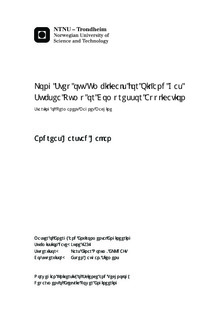| dc.description.abstract | Topside Variable Speed Drive (VSD) feeding a subsea load via a long cable is not a new technological challenge and many features in systems feeding asynchronous machines are well known. For a synchronous machine the situation is different as a net positive machine torque is not guaranteed. Therefor an analysis of the start sequence of such machine is of interest.
In this work starting of a Permanent Magnet Synchronous Machine (PMSM) powered by a VSD via a long subsea cable have been studied. Long transfer distance gives need for increased cable voltage, and thus transformers are introduced. A dynamic simulation model has been developed in SIMULINK? SimPowerSystems? consisting of voltage source, saturable transformers, cable, machine and mechanical load.
To synchronize the machine the electrical frequency is lowered as suggested in literature with the result that the system impedances change compared to steady state and resistance become the dominant parameter. Source voltage amplitude must also be reduced accordingly to avoid iron core saturation. The consequence is that the large cable voltage drop result in insufficient start up torque produced by the machine when a stiction torque around 30 % is present.
The mentioned dynamic simulation model has been used to compare system modifications proposed in literature to an unmodified base case with a cable length of 50 km. This have been done to investigate how stiction torque affects the start sequence and to draw conclusions about which method gives the most benefits for this type of machine. The main cases tested are increased voltage/frequency ratio, reduced cable resistance and machine damping.
If the electromagnetic torque produced overcomes stiction torque the rotor is set into motion. Because of the rotor and load inertia and the high opposing friction torque rotor oscillations around zero speed is not avoided for any of the cases when stiction torque is applied. Oscillation motion is assumed to heat up the bearing oil such that the static torque is reduced and eventually synchronous operation is achieved after several seconds. It is shown in this work that what separates the cases where sufficient torque is produced is the time the machine uses to reach synchronism.
All modifications shows improvement compared to the base case. Damping and voltage boost are the modifications with the most promising results for a broad range of stiction torques. This is expected as damping gives a net positive torque as in an induction machine, and that voltage boost directly increases the machine current. Higher voltage boost is better, but may easily lead to transformer saturation so this method must be used with great care. A rotor design with very high damping may result in a machine with lower air gap magnetic flux and conversely lower electromagnetic torque. The tradeoff between the modifications must be considered for each specific system.
Oscillations are found to be present to the same degree independent of initial power angle. This means that as long as no dynamic control strategy is applied one does not have to take into account the initial angle of the rotor relative to the stator field.
The assumption about reduction in static friction in the mechanical load should be tested in laboratory or existing installations. No cost- or sizing considerations are included in this work. In relation to offshore installations space requirements may often be an issue, but this has to be considered in each specific case. Resonance conditions must be treated with great care in such system and could be subject for further studies. Off special interest are multilevel inverters producing a very low harmonic output. A great challenge is to achieve general results and models that may be part of a tool box for system development in the future. The model developed here may be a part of such tools. | |

